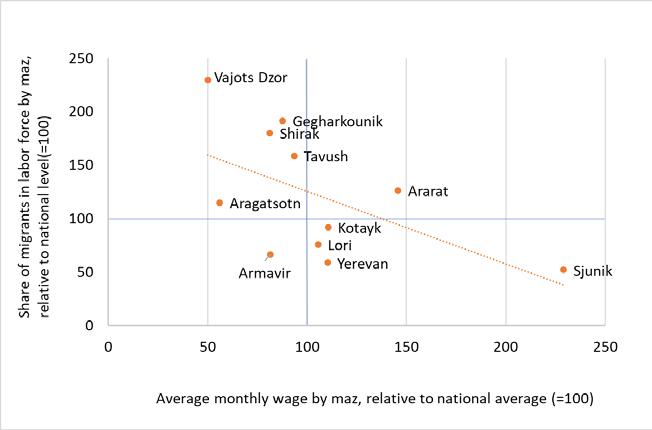
3 minute read
6. COVID 19 exacerbating vulnerability of Armenian migrant households
Figure 7. Current migrants are more likely to be unemployed prior to leaving Armenia (marginal effects)
Source: Authors’ estimation, using RAU survey data 2015-17.
Advertisement
A decrease in labor migration could worsen the welfare of migrant households and the domestic economy. Remittance inflows were estimated at $1.5 billion (or 11.4 percent of GDP) in 2019, according to World Bank. These flows to the Europe and Central Asia region are projected to fall sharply, by about 28 percent, owing to the combined effect of the pandemic and nose-diving oil prices (World Bank, 2020b). The effect is expected to be felt sharp for Armenia, owing to its high dependence on remittances from Russia. The Kyrgyz Republic saw remittances falling by 9 percent in the first two months of 2020, compared with the same period of 2019 (ibid).
Lower remittance inflows can generate a sudden income shock in migrant households and could make substantial impacts on poverty. The effects would be exacerbated if migrant household members in Armenia lost jobs due to COVID-19 crisis. Foreign earnings account for more than one-third of household income in migrant households (Figure 8.a). Remittances support households’ basic needs as well as health and education expenditures (Figure 8.b). A fall in remittances thus could increase poverty among Armenians, as well as depress wages through falling consumption demand19. As shown in Table 2 below, migrant households have, on average, more dependents than non-migrant households. A 50-percent drop in remittances could increase poverty rate in poor households by 1.3 percentage points and moderately poor households by 1.1. percentage points (Fuchs et al., 2020).
Figure 8. Remittances account for more than a third of households’ income (percent)
19 Given its importance in the economy (accounting for some 11 percent of GDP in 2019), a sharp contraction in remittances is likely to bear broader macroeconomic implications, such as real exchange rates and current account balance, but this note refrain from delving into it, as the note is at the micro level - at the migrant and their household level.
(a) supplement income in migrant HHs

(b) …and finance consumption of basic needs and health
Source: RAU survey data (2018).

The impacts of the COVID_19 have the potential to worsen pre-existing inequalities. As Figure 9 shows, poorer marzes, proxied by an average wage by marz, send more overseas migrants, proportionate to regional population. Migrants go abroad to make higher income than in Armenia – indeed earning higher wages than their counterparts in Armenia (Honorati et al 2019a). Remittance-dependent households tend to be in rural areas and agricultural households (OECD, 2018), and remittances contribute to boosting aggregate demand in rural households (World Bank, 2017). Therefore, a decline in remittance inflows could contract economic activities in poorer regions and rural areas, potentially resulting in widening income gaps across regions, and between rural and urban areas.
Figure 9. Migrants are proportionately more from poorer regions
Source: RAU survey data (2018); AMS. Wages in April 2020.

It is unclear how a decrease in labor migration would influence labor force participation rates of migrant households. Earlier studies suggest that inflows of remittances reduce labor participation of migrant households (OECD, 2018); at the same time OECD (2018) suggest that women left behind compensate the absence of a male household member (who migrated) with their labor, especially in the event of no remittances. Honorati et al (2019a) find from RAU survey data that in fact, having a migrant as a member of the household is likely to raise the probability for labor force participation by other household members.




